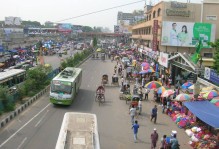Journey and Beginnings in India
I want to start off this blog by telling you a little bit about travelling for twenty-five hours. The journey was very bizarre. Spending so many hours in an airplane was as if I was living in a world where all I do is sit, eat, stretch, talk, and try to sleep. Simply put, it is an experience that I am glad had a seven hour layover in Dubai.
As I stepped out of the airport in Hyderabad and found myself within such a high population density, I decided that I will use every opportunity to learn as much from my time in India as possible. There are so many stories that I am unaware of right in front my eyes. I want to hear the stories of those who are subjected to women and child rights issues that continue to exist in India, including sexual abuse and child marriages. I want to see the impact of stark healthcare inequality on the efficiency of hospital management and the health issues in a rural community. During this semester, my goal is to come across global issues in a way that I have never been introduced to before.
Child Labor and Hypocrisy
Last week, I discussed the prevalence of child labor and child marriages in India with a previous UNICEF Child Protection Officer. One topic that especially interested me is that people sound hypocritical when trying to justify the use of child labor. When asked about the issue of child labor in India, some people respond by saying that their work is necessary both for their families and the Indian culture. They say that some families depend on the children to improve their financial situation; however, in a country where academics are constantly becoming more competitive, children who work don’t have the time or opportunity that they need to improve their long-term financial situation through education. Also, some people try to justify child labor by saying that cultural work such as painting artifacts will ensure that Indian culture is spread through each generation. But, when asked, they say that they would not put their own children through the same kind of work. For me, Indian culture should not consist of child labor; sustainability of culture through child labor just does not make sense.
Mandibular Fracture
I watched my first surgery in India last week, and I am so excited for the next three months. This surgery was in the afternoon; I had seen the patient come in for a consultancy the previous morning so I knew the context of the surgery, and I was prepared to see to how his jaw fracture would be repaired. The equipment that was used for the surgery was, at least seemingly, very similar to the equipment that was used in surgeries that I have seen in a clinic in the US. Even though the procedure was only three hours long, the physician was working with his staff since the previous day to make sure that the surgery can be properly done on time. This procedure consisted of open reduction and internal fixation. After giving the patient general anesthesia, arch bars, which are steel bars, were placed on the patient’s upper and lower teeth to align the teeth. The interesting part is that this alignment of teeth aligned the jaw bone, which was in two parts because it was fractured, and two plates were placed on the two sections of the jaw bone to hold the jaw bone in place. The surgery was so neatly done that I was very involved in the procedure. Although the surgery went well and the patient is finally able to eat without cringing pain, it will take him weeks to fully recover.
Every day of last week felt longer than a usual day because I was being introduced to so much information. This week has been even more interesting, and I can’t wait to tell you a little bit about it next week.



No comments.
Comments are currently closed. Comments are closed on all posts older than one year, and for those in our archive.